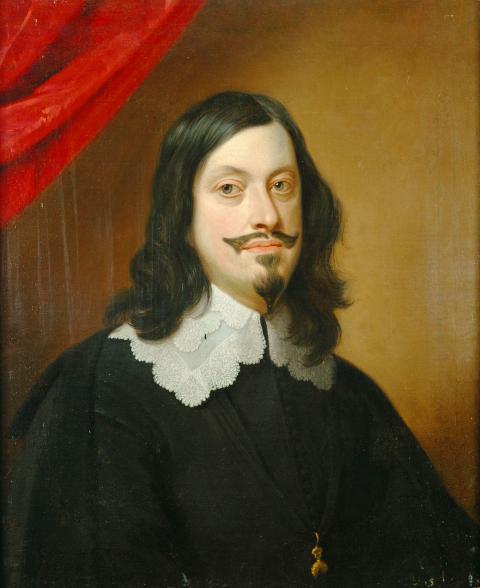As the name implies, a suite is a collection of short, stylistically different dances. They were a very popular form of composition during the Baroque period. The French ordre and suite and the Italian partite are just different words meaning the same thing.
In previous Bilingual Music articles we have seen how certain French Baroque composers would append unique — and often inscrutable — titles to individual dances within the suite. Yet, the music behind these mysterious titles actually has a set logic and sequence. That is, they would start with an allemande, followed by a courante, then a sarabande and perhaps a gavotte, and conclude with a gigue.
The German Baroque composer Johann Jakob Froberger (1616-1667) is generally regarded as the person who established the accepted sequence of the suite. The manuscripts he presented to the Holy Roman Emperor Ferdinand III have been preserved, and they became the model for later composers to follow.

Photo: Wikimedia Commons
照片:維基共享資源
Suites generally commence with a moderate tempo allemande (originally from “Allemagne,” the French word for Germany), providing a solemn opening to the music. This is followed by a faster tempo triple-meter courante, the name coming from the Italian word for “running,” as in flowing currents. The music then slows down to the moderate pace of the sarabande, a dance originating in the Spanish colonies in South America, a lively and energetic musical style that was tamed when brought across to Europe and transformed into the adagio dances popular in European court music. The gigue, a lively folk dance often used to end the suite with a final flourish, originated from the Irish jig imported to Europe in the mid-17th century before court composers gradually wove a contrapuntal texture into it.
While Baroque composers inherited Froberger’s order, they also introduced other dance styles, known as galanteries, which included elegant, lighter minuets and agile double-time French bourree and gavotte, as well as the chaconne and passacaglia, which were used for variations and later used by Johann Sebastian Bach, among others, to create their masterpieces.
(Translated by Paul Cooper)
巴洛克音樂中的「組曲」,顧名思義是由數首風格殊異的簡短舞曲組成,曾經是該時期最受歡迎的作品類型。法文「ordre」、「suite」,或義大利文「partite」其實指的都是「組曲」。
在日前的專欄中,我們知道法國巴洛克作曲家會為組曲中的各首短舞曲冠上獨特──又經常讓人摸不著頭緒──的神秘小標題。然而,這些標題背後的音樂本身仍然有著一定的規律和順序:通常以德國舞曲開頭,接著是庫朗舞曲,再依序演奏薩拉邦德舞曲、嘉禾舞曲等,最後以吉格舞曲結尾。
德國的巴洛克作曲家約翰‧雅各‧弗洛貝爾格(西元一六一六~一六六七)今日咸認為是「組曲」順序的奠基者,他致贈給神聖羅馬帝國皇帝斐迪南三世的手稿都被完整地保存下來,進而成為日後作曲家的創作典範。
組曲通常由速度溫和且偏慢的「德國舞曲」(音譯為阿勒曼德,源自於法文中的「德國」一字)展開整部作品,彷彿莊嚴的進場音樂。隨後接入三拍子的「庫朗舞曲」,速度極快,就像是該字的義大利文來源,呈現出水流的奔馳感。音樂隨後速度放慢,轉入溫柔和緩的「薩拉邦德舞曲」。這類音樂最初源自於西班牙在南美洲的殖民地,生動活潑的音樂風格在傳回歐洲大陸後遭到馴化,成為宮廷音樂中常見的慢板舞曲。充滿活力而富有民俗風味的「吉格舞曲」源自於愛爾蘭,在十七世紀中期傳入歐洲大陸,在宮廷作曲家們的筆下逐漸加入對位的音樂織理,通常被用來作為組曲的華麗壓軸。
在承繼弗洛貝爾格奠定的組曲結構之外,巴洛克作曲家亦會視情況與個人喜好加入其他的舞曲類型,稱為「組曲」內的「華麗曲」(galanteries),這些「可供選配」的音樂包括了優雅又不失輕盈的小步舞曲、輕快的二拍子法國「布雷舞曲」、「嘉禾舞曲」,以及「夏康舞曲」和「帕薩卡利亞舞曲」。具有變奏功能的後兩者,日後更成為包括巴赫等許多作曲家譜下扛鼎之作的載體。
(台北時報章厚明撰)

Bilingual Story is a fictionalized account. 雙語故事部分內容純屬虛構。 Emma had reviewed 41 resumes that morning. While the ATS screened out 288 unqualified, she screened for AI slop. She could spot it a mile away. She muttered AI buzzwords like curses under her breath. “Team player.” “Results-driven.” “Stakeholder alignment.” “Leveraging core competencies.” Each resume reeked of AI modeling: a cemetery of cliches, tombstones of personality. AI wasn’t just changing hiring. It was draining the humanity from it. Then she found it: a plain PDF cover letter. No template. No design flourishes. The first line read: “I once tried to automate my

Every May 1, Hawaii comes alive with Lei Day, a festival celebrating the rich culture and spirit of the islands. Initiated in 1927 by the poet Don Blanding, Lei Day began as a tribute to the Hawaiian custom of making and wearing leis. The idea was quickly adopted and officially recognized as a holiday in 1929, and leis have since become a symbol of local pride and cultural preservation. In Hawaiian culture, leis are more than decorative garlands made from flowers, shells or feathers. For Hawaiians, giving a lei is as natural as saying “aloha.” It shows love and

A: Hard rock band Guns N’ Roses and pop diva Lady Gaga are finally touring Asia again. B: Are they also coming to Taiwan? A: The band will stage a show at the Taoyuan Sunlight Arena on Saturday. B: Wow, so this will be the band’s third visit. I really love its 1992 power ballad “November Rain.” The nine-minute hit was the Billboard chart’s longest song at one point. A: Let’s go celebrate the 40th anniversary of its release. A: 硬式搖滾天團槍與玫瑰、女神卡卡終於再度展開亞洲巡演了。 B: 他們也會來台巡演嗎? A: 槍與玫瑰本週六即將在桃園陽光劇場開唱唷。 B: 哇這將是該團第三次來台演出,我超愛他們1992年強力情歌《November Rain》,全長近9分鐘還曾是告示牌排行榜最長神曲。 A: 那我們一起去慶祝該團出道40週年吧! (By Eddy Chang, Taipei Times/台北時報張迪)

1. 他走出門,左右看一下,就過了馬路。 ˇ He walked outside, looked left and right, and crossed the road. χ He walked outside and looked left and right, crossed the road. 註︰並列連接詞 and 在這句中連接三個述語。一般的結構是 x, y, and z。x and y and z 是加強語氣的結構,x and y, z 則不可以。 2. 他們知道自己的弱點以及如何趕上其他競爭者。 ˇ They saw where their weak points lay and how they could catch up with the other competitors. χ They saw where their weak points lay and how to catch up with the other competitors. 註:and 一般連接同等成分,結構相等的單詞、片語或子句。誤句中 and 的前面是子句,後面是不定詞片語,不能用 and 連接,必須把不定詞片語改為子句,and 前後的結構才相等。 3. 她坐上計程車,直接到機場。 ˇ She took a cab, which took her straight to the airport. ˇ She took a cab and it took her straight